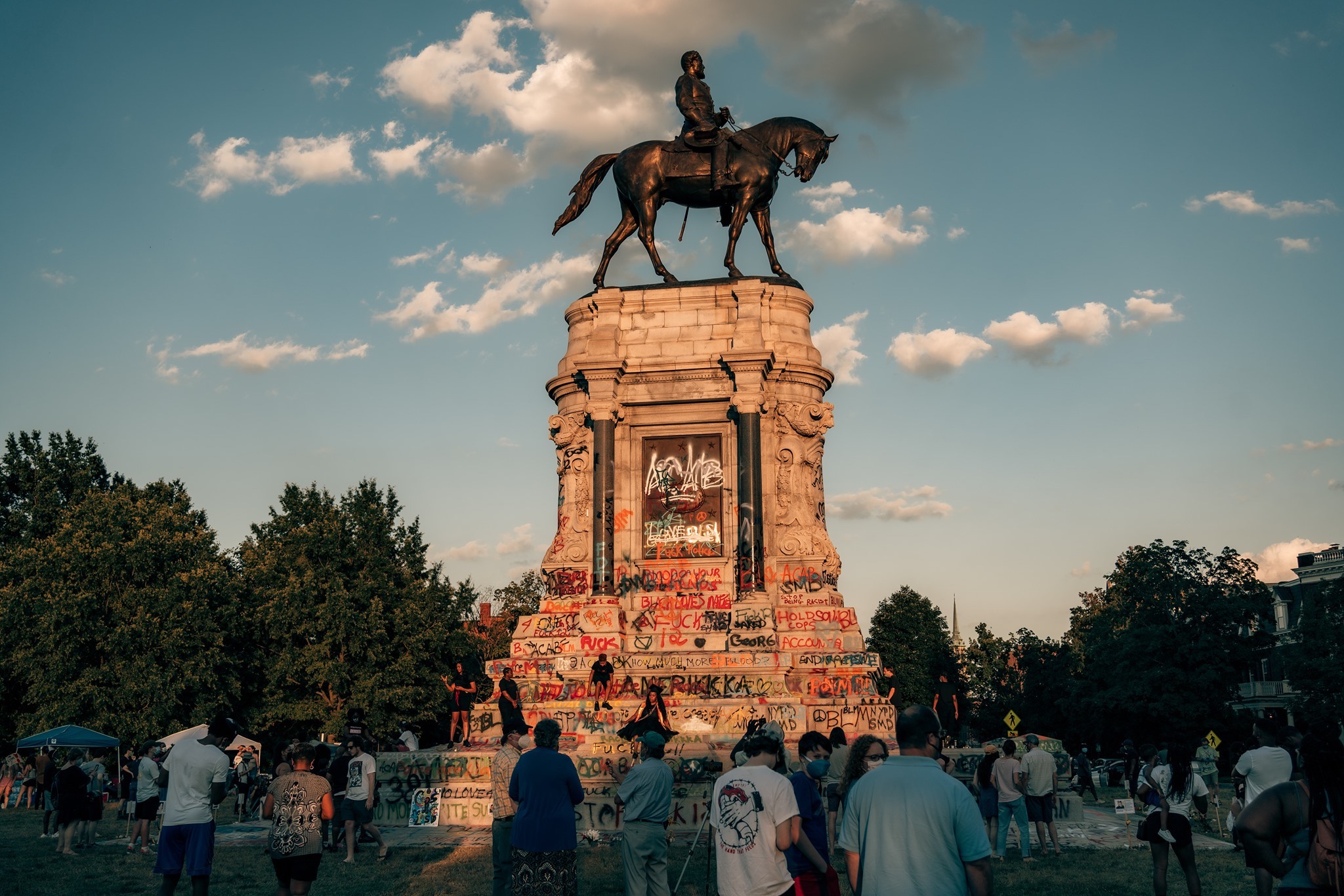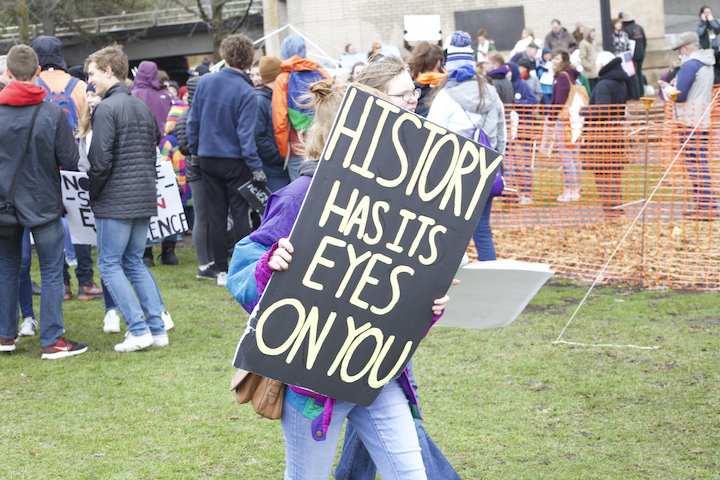Report by Briana Loveall
To Fool the Eye

January 2018
It was my first time on the East Coast. Richmond, Virginia—a liberal college town invested in fine dining, breweries, and free museums—seemed like the perfect place to start. Back before anyone had heard of COVID-19, it pulsed with life. On weekday nights, the streets teemed with people, black and white, moving in and out of restaurants and theaters. The range of skin color was a pleasant shock. I’m a white woman in my late twenties, and after the vast whiteness of Spokane, my hometown in the Pacific Northwest, I suddenly found myself in the minority.
I reveled in the diversity. Everyone always seemed to be laughing. At dinner, the first night, as I slurped away at pork udon noodles, I had to raise my voice over the din of the restaurant I sat in with two friends I'd known since childhood, my Richmond hosts. The tiny building was packed with bodies; patrons hunched over bowls billowing with steam. The noise and chaos created contrary feelings of intimacy and safety.
On the second day of my visit, we went to the Confederate White House. Jefferson Davis, president of the Confederacy, and his family occupied it during the Civil War. My friend Gina (not her real name) suggested the tour, saying she’d taken it herself and found it interesting, but I had mixed feelings about going. In August 2017, a few months before my arrival in Richmond, a white-supremacist and neo-Nazi rally held in nearby Charlottesville had left one counter-protester dead and others injured. The white supremacists, many of whom marched with Confederate flags, opposed the removal of a monument to General Robert E. Lee.
At the time, this led to a national debate about the purpose of preserving Confederate history. I was just entering the ongoing conversation, but I considered whether something as simple as a tour of a historic site could be construed as silent consent to ignore a racist past.
On the morning of our visit, the White House of the Confederacy seemed well-preserved. Our tour guide, an older white man whose voice dripped with boredom, said it had been condemned and restored several times. He claimed its current condition was as close to the original as possible. One of his canned anecdotes—I took notes—was about First Lady Varina Davis coming back to the house long after the Civil War had ended to donate memorabilia. This would have been in the late 1800s and before 1906, when Varina died at eighty. According to my notes, the guide said Varina was “in her eighties” when she stopped by to approve the latest remodel.
The Davises, the guide told us, also suffered much more than just the loss of the Civil War. Of her six children, Varina outlived all but one, a daughter named Margaret. In a nursery strewn with yellowed dolls and toy cannons, the guide recounted the different Davis children who had lived there—especially one young son who died in an accidental fall.
In the front parlor, Grecian statues ignored us. The white-marbled women were corpulent, delicate.
“It’s called Trompe-l’oeil,” the guide said, pronouncing it trump-loo-ee and interrupting my admiration for such meticulously crafted art. “It means to fool the eye.”
The statues were fakes: hollow, plaster-like replicas designed to raise the social status of the owners. Throughout the house, the guide pointed out more fraudulent items: a baroque chandelier, a chaise lounge chair, a granite fireplace. The French phrase was new to me, although the concept was not.
Ultimately, it was a disheartening tour. I imagined that others who took it were reminded of the abolition or of current political tensions surrounding Confederate flags and statues. Maybe visitors left the Confederate White House and were reminded of how far we’ve come. But I left thinking it was foolish to believe we had come that far at all.
Back at the American Civil War Museum, which adjoined the White House grounds, we studied the clothing of Confederate soldiers, their tin plates and knives for eating. We read about the tactical strategies of the South and the numbers of young boys who died of starvation and disease. It was a litany of unidentified mothers’ mourning.
A small case was filled with more current memorabilia addressing the controversy over Confederate statues. A bright red bumper sticker read Heritage Not Hate—a response, I assumed, to why a contemporary white Southerner might choose to bear the Confederate flag. Other artifacts included a Dukes of Hazzard plate, a Confederate-flag lunchbox, and a comic book—Captain Confederacy—with a black woman as the white captain’s superhero partner on the cover.
After lunch, we spent several hours in Washington, D.C., wandering the National Mall. A paved loop takes walkers past the Washington Monument, the Reflecting Pool, the US White House (across the street), the Lincoln Memorial, and the Vietnam Wall.
Snipers sat on the rooftops, perched like vultures. It happened to be Martin Luther King, Jr., Day. Outside the Lincoln Memorial, a man held a sign in protest. Dressed in old military fatigues, he didn’t move as I approached to read his silent shout to the world: What would Martin Luther King Say? …America will become a shithole country.
Inside the Memorial, the air was cold and hushed. Lincoln stared down, in approval, in dismay—it was hard to tell.
• • •
June 2020
When I wrote this piece more than two years ago, I hadn’t yet participated in my first protest. It’s hard to compare the memories of the city I fell in love with then to current images of Richmond’s buildings burning, its statues covered in graffiti or toppled over like chess pieces. My friends still live there, and they’ve been messaging me about the curfews, the bang and smoke that peppers their dreams. In the morning, they tell me, they have to check the news, because they don’t know if what they heard during the night was real.
In college, I admired friends whose parents had encouraged them to attend events that mattered to them, who had joined antiwar marches during the Bush administration and wore pink-knitted pussy caps for various women’s marches. After the Parkland high school shooting in February 2018, I brought my daughter, then eight, to her first march—and mine—in Spokane.
I felt power in that throng of people, as we shouted out our anger and pain, asking the nation to hear our grief and bear it with us. Our voice is the most powerful weapon we have, my daughter said, as she marched alongside me. Police lined the streets, helping to redirect car traffic and raising their hands in occasional salutes to a person or a sign. Pictures from that day show throngs of pale bodies, wrapped in scarves and gloves to ward off the cold.
Last week, at a protest for the murder of George Floyd, I left my daughter at home. Although Spokane would later erupt in a mild burst of violence, it was nothing compared to what other cities have faced. Protesters wore goggles, masks, and thick clothing in anticipation of tear gas and the force of a baton’s downward swing, but we marched the mile from the park to the city courthouse without incident.
At one point, a white couple walked near me, each toting a small child on their shoulders. I praised them for bringing their children—but then I stepped closer and more quietly asked if they weren’t afraid.
The father’s smile was kind. It reminded me that black parents are afraid for their children every day. He said it was important for his children to see the need for change.
Today, too many Americans watch the “riots,” the “looting,” and think this is the truth. Like those Grecian statues at the Confederate White House, waste and destruction appear to be the only narrative we can attach to complicated events. We’ve fooled ourselves into believing there's only one way to remember history, only one people who have the right to write it.
I wonder if the Confederate White House will be the next artifact to go. I recall the nursery, strewn with toys, cribs, and cots. I imagine Varina Davis pacing through it, clenching her hands as she thought of her children dying, while in the next room Jefferson Davis drafted battle plans against the Northern armies. I think of the sign I’ve now seen repeatedly:
All mothers were summoned when George Floyd called out for his.
At last week’s protest, a small boy sat perched atop his father’s shoulders. The marchers started chanting again, I can’t breathe, I can’t breathe. I felt the power of the chant like the beat of my heart.

Publishing Information
- Website for the American Civil War Museum and the White House of the Confederacy.
- “Varina Davis” (biography under “The Civil War in America”), Library of Congress.
- “The Other White House” by William Seale, White House History, Spring 2009 (the White House Historical Association).
Art Information
- Defaced Statue of Robert E. Lee, Richmond, Virginia (June 2020) @ Alex Scheller; used with permission.
- Protester with sign at Lincoln Memorial (January 2018) and Protester with sign in Spokane (February 2018) © Briana Loveall; used with permission.
 Briana Loveall is a freelance writer who lives in the Pacific Northwest. In 2017, she earned her MFA from Eastern Washington University. In 2019, she was a finalist for CutBank’s Montana Prize for Creative Nonfiction. She was also a semifinalist for the 2019 Boulevard nonfiction contest. Her works have appeared in the Rumpus, Sweet, Under the Gum Tree, the Forge, Crab Orchard Review, Glassworks Magazine, and others.
Briana Loveall is a freelance writer who lives in the Pacific Northwest. In 2017, she earned her MFA from Eastern Washington University. In 2019, she was a finalist for CutBank’s Montana Prize for Creative Nonfiction. She was also a semifinalist for the 2019 Boulevard nonfiction contest. Her works have appeared in the Rumpus, Sweet, Under the Gum Tree, the Forge, Crab Orchard Review, Glassworks Magazine, and others.
